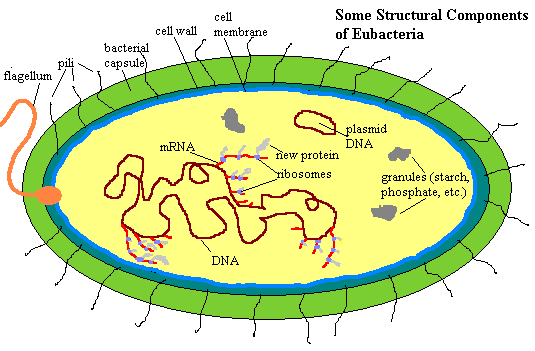The cell structure of eubacteria is as follows:

-
Capsule: The Eubacterial cells are usually surrounded by capsule made up of polysaccharides or polypeptides. Its presence is important in the disease-causing ability of some bacteria (Eg. Pneumococcus). The capsule is protective in function. Its stores food material and acts as the site for disposal of waste material.
-
Cell wall: Beneath the capsule is the rigid cell wall. The Eubacterial cell wall is composed of Peptidoglycan (Polysaccharides + Proteins). The cell wall gives characteristic shape to the cell and also protects the cell from high osmotic pressure differences.
-
Flagella: They are long appendages which are made up of flagellin molecules. They are used for locomotion as they move in a longitudinal wave-like action. Each bacterial cell may have one, few or numerous flagella located at different positions on the cell.
-
Pili or Fimbriae: Pili are short, hair-like appendages which arise from the cell membrane and extend beyond the cell wall. Pili are composed of the protein Pilin or Fimbrillin. Fimbriae function as organs of attachment by which bacteria attach themselves to the plant or animal cells. Pili play an important role during Sex Conjugation.
-
Plasma membrane: This is a semi-permeable lipid bilayer membrane. It is mainly composed of lipids and proteins. It is responsible for transport of specific ions, molecules, nutrients and wastes across the membrane.
-
Mesosomes: They are invaginations of the plasma membrane in the form of vesicles and tubules. They increase the surface area for transportation, control the activity of autolytic enzymes, carry site of attachment for signal peptides and involves in septum formation during cell division.
-
Nucleoid: It is the DNA or genetic material of bacteria. It consists of a single, large DNA double helix which is in the form of a highly folded DNA ring without nuclear envelope. The bacterial DNA is usually called the chromosome or chromatin body.
-
Ribosomes: The cytoplasm contains the 70S ribosomes smaller than the eukaryotic ribosomes. They play an important role Protein synthesis by translating the genetic message in m-RNA into proteins.
-
Storage granules: The cytoplasm contains large granules of storage materials. They serve as storage house of cell and organic compounds. The different types of storage granules found are: Polyphosphate granules or volutin granules, poly-β-hydroxybutyrate, Sulfur inclusion and polyglucan granules.
REFERENCE:
-
Image: http://palaeos.com/bacteria/images/EubacteriaStructure.gif